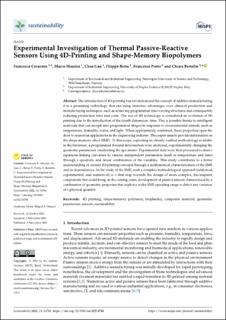| dc.description.abstract | The introduction of 4D printing has revolutionized the concept of additive manufacturing; it is a promising technology that can bring immense advantages over classical production and manufacturing techniques, such as achieving programmed time-varying structures and consequently reducing production time and costs. The rise of 4D technology is considered an evolution of 3D printing due to the introduction of the fourth dimension: time. This is possible thanks to intelligent materials that can morph into programmed shapes in response to environmental stimuli, such as temperature, humidity, water, and light. When appropriately combined, these properties open the door to numerous applications in the engineering industry. This paper aims to provide information on the shape-memory effect (SME). To this scope, exploiting an already verified methodology available in the literature, a programmed flexural deformation were analyzed, experimentally changing the geometric parameters constituting the specimens. Experimental data were then processed to derive equations linking curvature to various independent parameters (such as temperature and time) through a quadratic and linear combination of the variables. This study contributes to a better understanding of current 4D-printing concepts through a mathematical characterization of the SME and its dependencies. In the study of the SME, such a complete methodological approach (analytical, experimental, and numerical) is a first step towards the design of more complex, bio-inspired components that could bring, in the coming years, development of passive sensors characterized by a combination of geometric properties that exploit a wider SME operating range to detect any variation of a physical quantity. | en_US |

